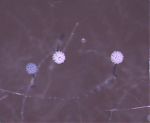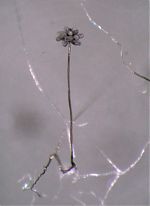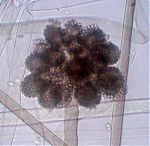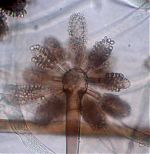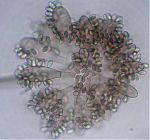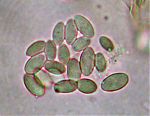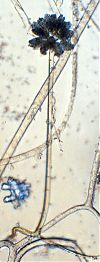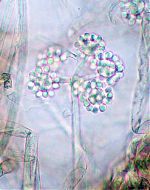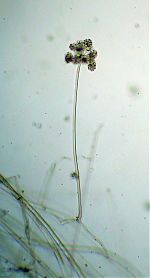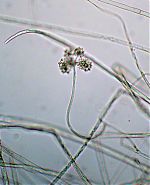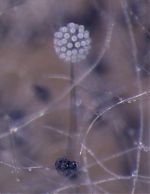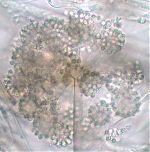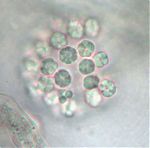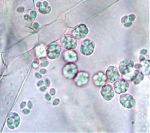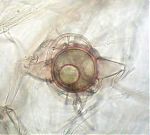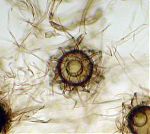Radiomyces
RADIOMYCES Embree, 1959 (Am. J. Bot. 46:25); 3 spp. (Benny and Benjamin, 1991—monograph).
= Radiomycopsis Pidopl. & Mil’ko, 1971 ( Atlas of Mucoralean Fungi, p. 95).
Species of Radiomyces form pedicellate, unispored or multispored sporangia over the surface of vesicles borne on a uniseptate stalk. Several of the vesicles with uniseptate stalks arise from a vesicle at the apex of an unbranched sporangiophore which has rhizoids at the base or forms directly from aerial mycelium. Zygospores have a hyaline, thin, and smooth zygosporangial wall, opposed suspensors, and branched suspensor appendages (Benny and Benjamin 1991).
Type species: R. spectabilis
Species of Radiomyces:
R. embreei R.K. Benjamin, 1960 (Aliso 4:526).
R. mexicana Benny & R.K. Benjamin, 1991 (Mycologia 83:718).
R. spectabilis Embree, 1959 (Am. J. Bot. 46:25).
The type species, R. spectabilis, has multispored sporangia and cylindrical spores (Embree, 1959). Radiomyces embreei forms obovoid spores in unispored sporangia (Benjamin, 1960). Radiomyces mexicana is also unispored but the wall of some parts of the anamorph and the zygospore wall are relatively thicker than the same structures in the other two species (Kitz et al., 1982; Benny and Benjamin, 1991). Species of Radiomyces are illustrated and described by Benny and BenjamIn (1991), Benny and Khan (1988), and Benny and Samson (1989).
All species of Radiomyces are coprophilous. Radiomyces is infrequently encountered in nature (Benny and Benjamin, 1991). Radiomyces was included in Cunninghamellaceae by Mil’ko and Beljakova, (1967, 1970), and Mil’ko (1974). Radiomyces is pathogenic to mice (Kitz et al., 1980) but the genus has not been reported to cause mucormycosis in humans.
Bibliography
Benjamin, R.K. 1960. Two new members of the Mucorales. Aliso 4:523-530.
Benny, G.L., and R.K. Benjamin. 1991 [1992]. The Radiomycetaceae (Mycorales; Zygomycetes). III. A new species of Radiomyces, and cladistic analysis and taxonomy of the family; with a discussion of the evolutionary ordinal relationships in Zygomycotina. Mycologia 83:713-735.
Benny, G.L., and S.R. Khan. 1988. The Radiomycetaceae (Mucorales; Zygomycetes). Calcium oxalate crystals on the sporangiolar wall and aerial hyphae. Scanning Microscopy 2(2):1199-1206.
Benny, G.L., and R.A. Samson. 1989. The Radiomycetaceae (Mucorales, Zygomycetes). II. Ultrastructural morphology of the mature zygospore and comparative morphology of the sporangiola and sporangiolar appendages. Memiors of the New York Botanical Garden 49:11-19.
Embree, R.W. 1959. Radiomyces, a new genus in the Mucorales. Am. J. Bot. 46:25-30.
Kitz, D.J., R.W. Embree, and J. Cazin Jr. 1980. Radiomyces a genus in the Mucorales pathogenic for mice. Sabouaudia 18:115-121.
Kitz, D.J., R.W. Embree, and J. Cazin Jr. 1982. Morphological and physiological studies of the genus Radiomyces. Mycologia 74:110-116.
Mil’ko, A.A. 1974. Opredeltiel’ mukoral’nykh gribov [ Key to the identification of Mucorales ]. ‘Naukova Dumka’ , Kiev, Ukraine. 303 p.
Mil’ko, A.A., and L.A. Beljakova. 1967. Rod Cunninghamella Matruchot I taxonomie Cunninghamellaceae [Genus Cunninghamella Matruchot and taxonomy of the Cunninghamellaceae]. Mikrobiologiya 36:684-690 [English translation available in Microbiology 36 (4):573-578, 1967]
Mil’ko, A.A., and L.A. Beljakova. 1970. The genus Choanephora Currey (Mucorales). Mikrobiologiya 38:894-902 [English translation available in Mikrobiologiya 38:864-770])
Updated Dec 03, 2008

